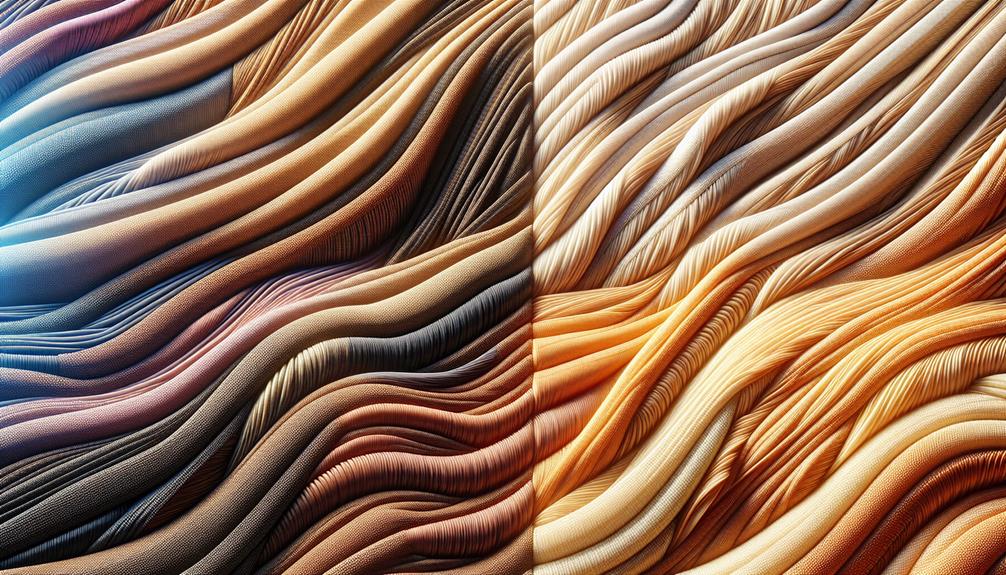When it comes to textiles, the debate between rayon and polyester often arises. At first glance, they may seem similar due to their synthetic nature, but the nuances between the two fibers are worth exploring.
While both have their merits, understanding how they differ in texture, stretch, and durability can shed light on which one may be more suitable for various applications.
So, which fiber truly reigns supreme in the domain of textiles?
Table of Contents
Key Takeaways
- Rayon is breathable and silky, while polyester is durable and moisture-resistant.
- Rayon is lightweight and drapes elegantly, while polyester retains shape and offers warmth.
- Polyester excels in elasticity and durability, contrasting with rayon's softness and breathability.
- Rayon is ideal for hot climates, while polyester is suited for cooler temperatures and long-term wear.
Characteristics of Rayon and Polyester
When comparing the characteristics of rayon and polyester, it becomes evident that each fiber has distinct properties that differentiate them from one another.
Rayon, a fabric derived from regenerated cellulose, boasts being breathable and moisture-absorbent, making it a favorable choice for summer garments. Its soft and silky texture sets it apart from the rougher feel of polyester, a synthetic fabric made from petroleum.
Unlike rayon, polyester isn't breathable and resists moisture, making it more suitable for cooler temperatures where warmth is desired. Rayon drapes elegantly and is often used for decorative purposes such as appliqué due to its lightweight nature.
On the other hand, polyester is preferred for structural purposes because of its durability against abrasion, mildew, and chemicals. Understanding these distinctions is vital when selecting the appropriate fabric for various projects or garments.
Differences in Texture and Luster
With their distinct characteristics, rayon and polyester exhibit notable differences in texture and luster. Rayon boasts a softer and silkier texture, offering a luxurious feel that's smoother to the touch compared to the stiffer and rougher feel of polyester.
Concerning luster, polyester tends to have a more artificial gloss, giving it a shinier appearance, while rayon presents a subtle shine reminiscent of natural silk. The luster of rayon is more organic in appearance, contrasted with the visibly artificial shine of polyester.
Additionally, rayon drapes better, providing a fabric that flows elegantly and is more flexible, enhancing its overall appearance. On the other hand, polyester retains its shape well and is known for its durability, but lacks the natural drape and softness that rayon offers.
These differences in texture and luster play a significant role in determining the overall look and feel of garments made from these two materials.
Stretchiness and Resilience Compared
Comparing the stretchiness and resilience of rayon and polyester reveals distinct differences in their fabric properties. Polyester stands out for its excellent elasticity and resilience, making it a preferred choice for activewear and stretchy garments. The elasticity of polyester guarantees that it retains its shape well, even after repeated wear.
In contrast, rayon is less stretchy than polyester due to differences in its structure and composition. Rayon may not bounce back as effectively as polyester, leading to potential issues with shape retention, especially when exposed to moisture. This difference in resilience means that polyester is often favored for items requiring durability and long-term shape preservation.
Understanding these distinctions in stretchiness and resilience between rayon and polyester can help in selecting the most suitable fabric for specific garment needs, whether prioritizing elasticity, durability, or moisture resistance.
Climate Suitability: Rayon Vs Polyester
In considering the climate suitability of rayon versus polyester, it becomes evident that each fabric offers distinct advantages based on temperature preferences. Rayon, known for being lightweight and breathable, is an excellent choice for hot weather conditions. Its ability to allow heat to escape makes it ideal for summer wear, as it helps in keeping the body cool and comfortable. Additionally, rayon's moisture absorption properties further enhance its suitability for hot climates by wicking away sweat and keeping the skin dry.
On the other hand, polyester is better suited for cooler temperatures. While it provides more warmth compared to rayon, it may not be as breathable in hot conditions. Polyester is designed to trap heat, making it a preferred choice for garments meant to offer insulation in cooler weather. Hence, when it comes to climate suitability, rayon excels in hot weather due to its breathability and moisture absorption capabilities, while polyester shines in cooler temperatures by providing warmth and comfort.
Breathability and Comfort Levels
When comparing rayon and polyester, it's crucial to contemplate their breathability and comfort levels.
Rayon excels in moisture absorption and air circulation, making it ideal for hot weather.
On the contrary, polyester lacks breathability and is better suited for cooler temperatures.
Moisture Absorption Differences
Rayon's moisture absorption and breathability set it apart from polyester, making it a preferred choice in warm climates for its comfort and cooling properties. Unlike polyester, which resists moisture, rayon absorbs sweat and allows it to evaporate, keeping the body dry and cool.
This moisture-wicking ability of rayon enhances comfort levels, especially during hot weather, making it an excellent option for summer wear. In contrast, polyester, with its moisture-resistant nature, is better suited for cooler temperatures where retaining warmth is essential.
The differences in moisture absorption between rayon and polyester directly impact their temperature suitability and comfort levels, with rayon excelling in breathability and moisture management, ideal for maintaining a cool and comfortable feel in warm conditions.
Air Circulation Comparison
I'll highlight the pivotal aspects of air circulation when comparing the breathability and comfort levels of rayon and polyester. Rayon proves to be more breathable, allowing for better air circulation and increased comfort compared to polyester. In hot and humid environments, rayon's moisture absorption properties make it a breathable choice, ideal for maintaining comfort levels. On the other hand, polyester's resistance to moisture inhibits proper air circulation, potentially leading to discomfort in such conditions. Rayon's natural fiber properties give it an edge over polyester when considering air circulation and overall comfort. Below is a comparison table showcasing the differences in air circulation and comfort levels between rayon and polyester:
| Aspect | Rayon | Polyester |
|---|---|---|
| Breathability | More breathable, allowing better air circulation | Less breathable, restricting airflow |
| Comfort in hot/humid | Ideal for hot and humid environments due to moisture absorption | Potential discomfort due to moisture resistance |
| Natural Fiber | Natural fiber properties contribute to enhanced comfort | Synthetic nature hinders the air circulation |
Cost and Durability Analysis
When comparing rayon and polyester, it's important to take into account the cost difference, longevity, and material strength.
Rayon is often more budget-friendly, but polyester tends to outshine when it comes to durability and resilience.
Understanding these aspects can help when making informed decisions when choosing between the two fabrics.
Cost Comparison
Comparing the cost and durability of rayon and polyester reveals clear advantages in affordability and resilience for polyester due to its synthetic nature and widespread availability. When considering cost and durability between rayon and polyester:
- Affordability: Polyester is generally more budget-friendly than rayon due to its synthetic production process and easy availability.
- Durability: Polyester is known for its durability, retaining its shape well and resisting shrinking and stretching over time.
- Maintenance: Polyester requires minimal maintenance to uphold its quality, making it a cost-effective choice for long-lasting items.
Longevity Assessment
Considering the cost and durability analysis of rayon and polyester, polyester emerges as the more long-lasting and cost-effective choice due to its superior resilience and longevity. Polyester's resistance to stretching and shrinking sets it apart from rayon, which is prone to losing shape and shrinking over time.
While rayon may seem more budget-friendly initially, the need for frequent replacements due to its durability issues can make it a less cost-effective option in the long run. For longevity, polyester's durability makes it a reliable choice for enduring wear and tear.
When prioritizing longevity and cost-effectiveness, polyester proves to be the more sustainable and economical option compared to rayon.
Material Strength
Polyester's durability outshines rayon with material strength, making it a more cost-effective choice for long-lasting items. When considering the strength and maintenance of materials like rayon and polyester, it's essential to evaluate their durability and cost-effectiveness. Here's a breakdown:
- Polyester's Resilience: Polyester is resistant to stretching and shrinking, providing better value for items that need to maintain their shape over time.
- Rayon's Delicate Nature: While rayon is luxurious and comfortable, it may require more care and maintenance to preserve its strength and appearance.
- Longevity Considerations: To balance cost and durability, consider the intended use and longevity of the item when choosing between rayon and polyester.
Comparison in Softness and Feel
Rayon feels noticeably softer and silkier to the touch than polyester. The softness of rayon is reminiscent of natural fibers like silk, providing a luxurious sensation against the skin.
In contrast, polyester has a rougher texture, lacking the smoothness and silkiness that rayon offers. When comparing the two, rayon drapes more elegantly and flows gracefully due to its soft nature, whereas polyester tends to be stiffer and less flexible.
The artificial feel of polyester is evident when touching it, as it lacks the natural softness that rayon possesses. The flexibility of rayon further enhances its comfort and drape, making it a preferred choice for garments where a softer and more flowing fabric is desired.
Practical Uses in Clothing
Moving from discussing the comparison in softness and feel, the practical uses of rayon and polyester in clothing reveal their distinct advantages for different weather conditions. When it comes to selecting the right fabric for your clothing based on the season, understanding the properties of rayon and polyester is important:
- Summer Wear: Rayon is ideal for lightweight, breathable summer clothing due to its cooling properties. It drapes well and is comfortable for hot weather conditions, making it perfect for summer dresses and tops.
- Winter Wear: In contrast, polyester is commonly found in winter wear for its warmth and insulation capabilities. It provides more warmth compared to rayon, making it suitable for cooler temperatures during the winter months.
- Versatility: While rayon is better suited for hot weather conditions, polyester's insulation properties make it a go-to choice for cooler temperatures, showcasing the versatility of these two fabrics in catering to different seasonal needs.
Washing and Care Instructions
Proper care instructions are essential for maintaining the quality and longevity of clothing made from rayon and polyester fibers. Rayon necessitates delicate handling, often recommending dry cleaning or hand washing to preserve its integrity. On the contrary, polyester is a breeze to care for, being machine washable and quick to dry.
Rayon's susceptibility to wrinkles means it may require ironing on low heat with a damp cloth to retain its appearance, while polyester can endure higher heat levels during ironing, simplifying its maintenance process compared to rayon. Whether opting for dry cleaning with rayon or machine washing with polyester, adhering to the proper care methods can significantly extend the lifespan of garments crafted from these materials.
Frequently Asked Questions
Which Is Better Polyester or Rayon?
When comparing polyester and rayon, it's important to take into account their unique qualities. Polyester excels in durability and shape retention, while rayon offers a softer, breathable feel. The choice depends on the specific needs – whether for comfort or longevity.
What Material Is Rayon Similar To?
Rayon is comparable to silk in softness and shine, often substituted for its luxurious feel at a more affordable price. Its likeness to cotton is noted, but it's more delicate, offering a silk-like appearance with cost-effectiveness.
What Fabric Is Polyester Closest To?
Polyester is most akin to nylon in synthetic fabric composition and properties. It also shares similarities with acrylic for durability and resistance to stretching, often compared to spandex for stretchability and shape retention, and serves as a wool substitute due to insulating properties.
Does Rayon Cling to Your Body?
Yes, rayon can cling to the body due to its absorbency and draping qualities. To prevent this, I recommend choosing a looser fit or blending it with polyester, which is less likely to cling.
- Why Is Red Velvet Not Red? - April 25, 2024
- How Do You Describe Velvet Fabric? - April 25, 2024
- How Strong Is Velvet? - April 25, 2024





